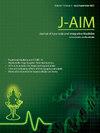Multimodal Ayurvedic intervention provided 15 years of progression free survival to a female patient with recurrent squamous cell carcinoma of tongue - A case report
IF 1.9
Q3 INTEGRATIVE & COMPLEMENTARY MEDICINE
引用次数: 0
Abstract
Oral Squamous Cell Carcinoma (OSCC) is the most common type of oral cancer, accounting for 90%–95% of all cancers in the mouth. It is typically noted in individuals over the age of 40, especially men between 60 and 80. However, there has been a recent increase in oral cancer cases among women and younger individuals. We present a case of a 49-year-old female diagnosed with Stage III, moderately differentiated Squamous cell carcinoma of the tongue in August 2005. The patient underwent radiation therapy (35 fractions/70 Gy) and received adjunct chemotherapy (6 cycles of Inj. Cisplatin – LD on October 21, 2005). Despite these treatments, residual induration on the tongue persisted, leading to a Knife biopsy in April 2007 that confirmed the presence of squamous carcinoma infiltrating the lingual muscles. Further, she underwent Wide Excision Glossectomy with Left Supra-Omohyoid Neck Dissection in May 2007 and Total Glossectomy with Hemi mandibulectomy with Left Supra-Omohyoid Neck Dissection in August 2011. In addition to conventional cancer treatments, the patient opted for Ayurvedic treatment at our center, which included a combination of oral Herbo-mineral metallic medicines and detoxifying Panchakarma procedures. The 12-year progression-free survival achieved in this case highlights the potential benefits of combining conventional cancer treatment with personalized adjunct Ayurvedic therapy.
多模式阿育吠陀干预提供了15年无进展生存的女性患者复发舌鳞状细胞癌-一个病例报告
口腔鳞状细胞癌(Oral Squamous Cell Carcinoma, OSCC)是最常见的口腔癌,占口腔所有癌症的90%-95%。它通常发生在40岁以上的人身上,尤其是60到80岁的男性。然而,最近在女性和年轻人中口腔癌病例有所增加。我们报告一位49岁的女性,于2005年8月被诊断为舌中分化鳞状细胞癌III期。患者接受放射治疗(35次/70 Gy)和辅助化疗(注射6个周期)。顺铂于2005年10月21日上市)。尽管进行了这些治疗,舌头上的残余硬结仍然存在,导致2007年4月的刀活检证实了浸润舌肌的鳞状癌的存在。此外,她于2007年5月接受了左侧肩胛舌骨上颈廓清术的大范围舌骨切除术,并于2011年8月接受了左侧肩胛舌骨上颈廓清术的全舌骨切除术和半下颌切除术。除了常规的癌症治疗外,患者还在我们的中心选择了阿育吠陀治疗,其中包括口服草药矿物金属药物和排毒Panchakarma程序的组合。该病例12年的无进展生存期突出了传统癌症治疗与个性化辅助阿育吠陀治疗相结合的潜在益处。
本文章由计算机程序翻译,如有差异,请以英文原文为准。
求助全文
约1分钟内获得全文
求助全文
来源期刊

Journal of Ayurveda and Integrative Medicine
INTEGRATIVE & COMPLEMENTARY MEDICINE-
CiteScore
4.70
自引率
12.50%
发文量
136
审稿时长
30 weeks
 求助内容:
求助内容: 应助结果提醒方式:
应助结果提醒方式:


